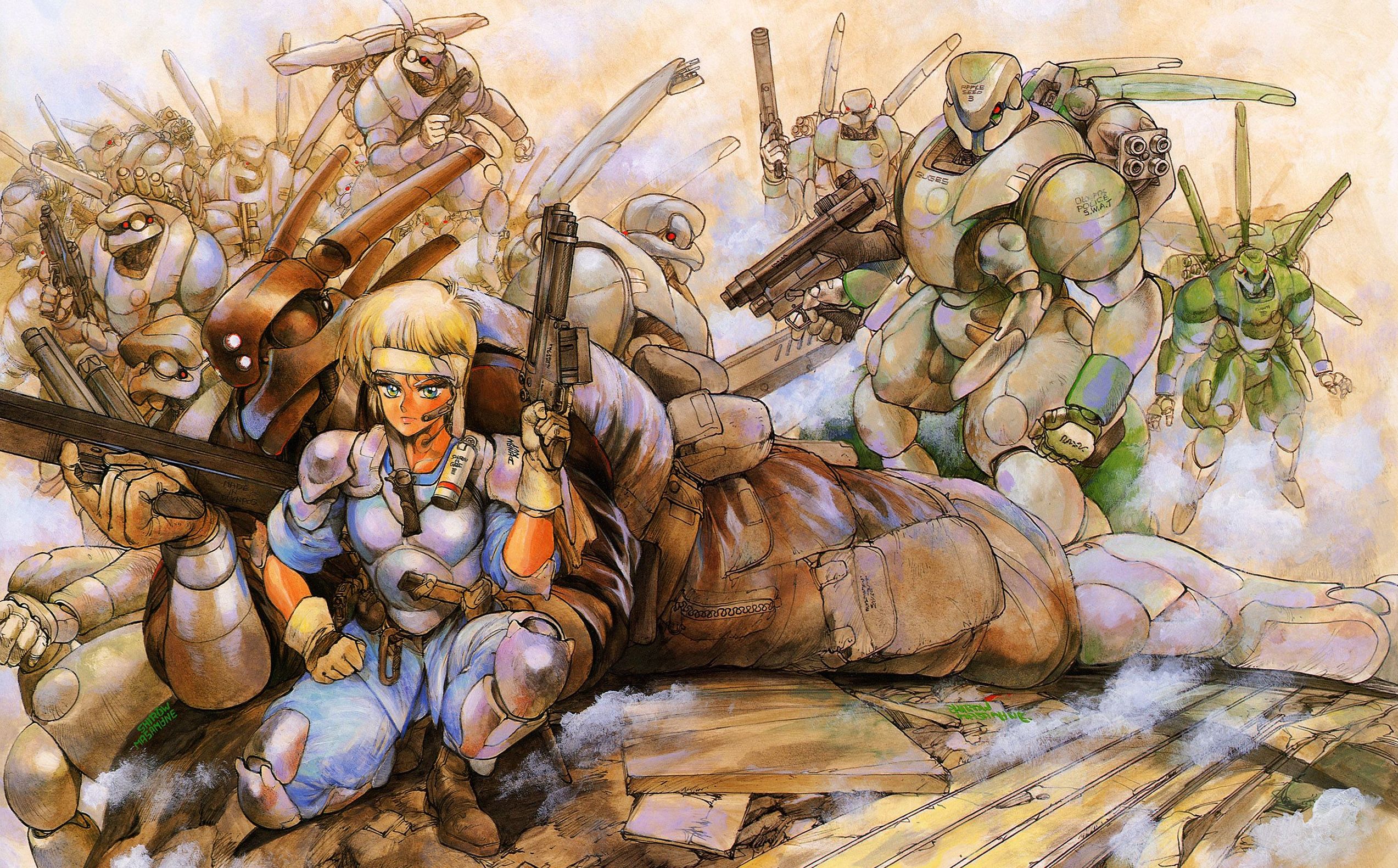 While Ghost in the Shell is Masamune Shirow’s best known work – one which we’ve written about previously – it’s far from his only one. There’s Black Magic, adapted into the anime Black Magic M-66. Dominion – the adorable story of a girl and her… er, tank. Then there’s Galgrease, about which I must firmly state, I know absolutely nothing. I’m sure it’s not exactly what it sounds like. Not at all… But second to Ghost in terms of popularity is Appleseed, which has spawned almost as many spin-offs: an original video animation, three feature films, a 13-episode TV series, and two video games. Though not, as yet, a mediocre live-action adaptation.
While Ghost in the Shell is Masamune Shirow’s best known work – one which we’ve written about previously – it’s far from his only one. There’s Black Magic, adapted into the anime Black Magic M-66. Dominion – the adorable story of a girl and her… er, tank. Then there’s Galgrease, about which I must firmly state, I know absolutely nothing. I’m sure it’s not exactly what it sounds like. Not at all… But second to Ghost in terms of popularity is Appleseed, which has spawned almost as many spin-offs: an original video animation, three feature films, a 13-episode TV series, and two video games. Though not, as yet, a mediocre live-action adaptation.
Appleseed was Shirow’s first “professional” work, coming out after Black Magic had brought him to the attention of Harumichi Aoki, head of the Seishinsha publishers. The story began appearing in February 1985. Unusually, rather than being serialized, it was released directly to paperback, but was a critical and commercial success, winning the 1986 Seiun Award for Best Manga. Three further volumes followed over the next four years; a fifth was initially serialized in Comic Gaia, but remains incomplete, thirty years after it was started. Shirow says Appleseed didn’t suit the structure imposed by the serial format.
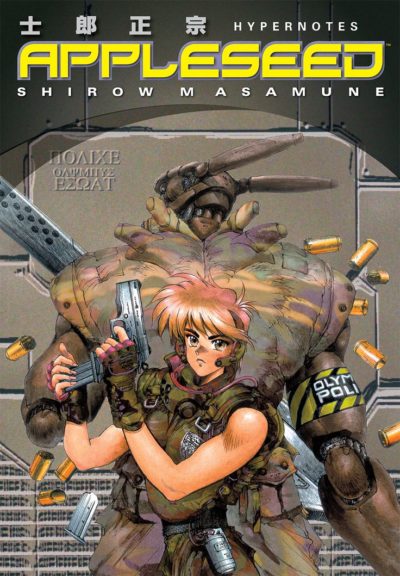 Compared to Ghost in the Shell, I think Appleseed is a bit more approachable. While there are still nods to the topic, it doesn’t seem to lean quite so heavily on existential debate about the nature of self, especially with regard to the central character. Deunan is considerably more “human” than Motoko Kusanagi, and even though her partner, Briareos, is heavily enhanced, there are no real questions about his humanity. The issues are more around the bioroids. These are artificial humans, created with deliberately suppressed emotions, a limited lifespan (like the replicants in Blade Runner), and no ability to have children. Intended to serve humans, by acting as a restraint on our less appealing traits, their status and nature are a hot-button topic in the society here, with strong opinions on both sides.
Compared to Ghost in the Shell, I think Appleseed is a bit more approachable. While there are still nods to the topic, it doesn’t seem to lean quite so heavily on existential debate about the nature of self, especially with regard to the central character. Deunan is considerably more “human” than Motoko Kusanagi, and even though her partner, Briareos, is heavily enhanced, there are no real questions about his humanity. The issues are more around the bioroids. These are artificial humans, created with deliberately suppressed emotions, a limited lifespan (like the replicants in Blade Runner), and no ability to have children. Intended to serve humans, by acting as a restraint on our less appealing traits, their status and nature are a hot-button topic in the society here, with strong opinions on both sides.
It’s this tension which tends to drive the plot in a lot of the adaptations. For example, some terrorist groups are opposed to the bioroids’ existence on basic principle, fearing they will replace humanity. Conversely, others are working towards that very end, with an equal passion and lack of aversion to violence. Interestingly, each adaptation has been different from the one before. They each apply their own spin to the characters and topics; there’s not much that’s truly “canon” about, for example, the origins of Deunan and Briareos. In the original manga, they were officers in a SWAT team from Los Angeles, but that isn’t always necessarily the case.
But there are generally elements in common. They take place after a devastating (though fortunately, non-nuclear) war has torn civilization apart. Hope of a better future, however, lies in the shape of utopian city Olympus, which has risen from the ashes. There, the bioroids mentioned above (and which I keep wanting to call “bioDroids”!) keep things running smoothly, in a paradise compared to the war-torn remains of life outside its walls. However, as we’ll see, there’s no such thing as a paradise… Or, at least, opinions on what that should be, differ radically.
Over the first week in June, we’ll be looking at each of the adaptations of Shirow’s manga, from the 1988 OAV, Appleseed, through to the 2014 version, Appleseed Alpha. As they’re published, the reviews will also be collected below. But first, take some time to look at a few example of Shirow’s amazing artwork, which is every bit as luscious now, as it was when it was first published.
Appleseed (1988)
By Jim McLennan★★★
“Apples to oranges”
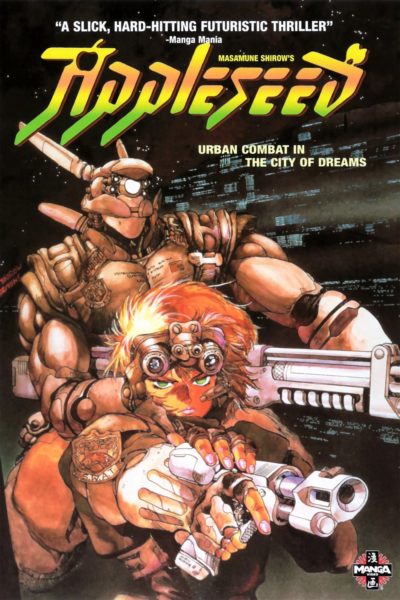 This feels like one of the first anime releases to get an official release in the West, and to be honest, the animation in particular is showing its age. It couldn’t be much more eighties, if the heroine had big hair and wore legwarmers while listening to her Sony Walkman. That said, when you get used to the relatively simple style, it’s decent enough. We are introduced to the post-WW3 world and in particular, the city of Olympus, which was designed to be a utopian environment for survivors. However, like all utopias, it failed to take into account human nature. In particular, some are very concerned by the prevalence of biodroids. These artificial creations were intended to be humanity’s servants, yet for their opponents, feel increasingly more like our masters.
This feels like one of the first anime releases to get an official release in the West, and to be honest, the animation in particular is showing its age. It couldn’t be much more eighties, if the heroine had big hair and wore legwarmers while listening to her Sony Walkman. That said, when you get used to the relatively simple style, it’s decent enough. We are introduced to the post-WW3 world and in particular, the city of Olympus, which was designed to be a utopian environment for survivors. However, like all utopias, it failed to take into account human nature. In particular, some are very concerned by the prevalence of biodroids. These artificial creations were intended to be humanity’s servants, yet for their opponents, feel increasingly more like our masters.
In that camp is terrorist A.J. Sebastian, who is working with a disgruntled Olympus police officer, Charon Mautholos (Furukawa) to bring about the collapse of Olympus and its all-powerful computer, Gaia. Against them stand the Olympus anti-terrorist forces, in particular Deunan Knute (Katsuki) and Briareos Hecatonchires (Sakaguchi). They are refugees from the blasted hellscape which forms much of the world, who were taken in to Olympus, and became part of its police force. Already bearing a grudge against Sebastian for his killing of a colleague during a hostage situation, they are not unhappy to be tasked with his extra-judicial killing by Olympus’s leader, the bioroid Athena Areios (Sawada). But with the help of Charon, Sebastian is one step ahead of the authorities.
As shown in the video below (you’re welcome!), the original release of the anime did have its fair share of bumpy moments. Several signs clearly refer to the city as “Olumpus”, which doesn’t quite sounds like the home of the gods! Similarly Charon is referred to as “Karen” in the subtitles, which has a rather different set of associations in 2021, never mind the gender confusion it caused. Finally, Briareos is called Buliaros: I guess they were still settling down in terms of his Western name. It’s also surprisingly low-key in terms of action. Once you get past the hostage rescue mentioned above, it’s really Sebastian and Charon that are responsible for much more of the mayhem than Deunan and Briareos.
I did like the characters here though. It’s clear the heroine and hero have an easy-going relationship, trusting each other implicitly. Yet the script still finds the time to give Charon a back-story which makes his action understandable in the circumstances. Sebastian, not so much, however; he’s just a villain. The world-building is generally solid, though I would like to have learned more about life outside Olympus, to provide some contrast. The soundtrack – something I remember as a highlight of many films and series of the time – is utterly forgettable. It’s no Bubblegum Crisis, that’s for sure, and is even further below Ghost in the Shell. Overall though, allowing for its age, it did keep me entertained; truth be told, considerably more than I feared it might.
Dir: Kazuyoshi Katayama
Star: Masako Katsuki, Yoshisada Sakaguchi, Toshiko Sawada, Toshio Furukawa
Appleseed (2004)
By Jim McLennan★★½
“Weak at its core.”
 This is obviously technically superior to its 1988 predecessor, with CGI done in a way that the people, in particular, look like cel animation. I suspect that being a theatrical release, rather than a original video animation, gave it a significantly larger budget, and it hits the ground running. The opening sequence is a bravura use of all the tricks in the CGI locker: swoops, zooms and majestic camera movements round a half-destroyed cityscape. Deunan (Kobayashi) fends off a host of enemies, but ends up being knocked unconscious, and taken to the utopian city of Olympus. There, she’s reunited with Briareos (Kosugi), and becomes part of the ESWAT team. But not everything is idyllic in Olympus, which is populated about equally by humans and vat-grown biodroids, who administer the city and keep humanity’s emotions and violent tendencies in check.
This is obviously technically superior to its 1988 predecessor, with CGI done in a way that the people, in particular, look like cel animation. I suspect that being a theatrical release, rather than a original video animation, gave it a significantly larger budget, and it hits the ground running. The opening sequence is a bravura use of all the tricks in the CGI locker: swoops, zooms and majestic camera movements round a half-destroyed cityscape. Deunan (Kobayashi) fends off a host of enemies, but ends up being knocked unconscious, and taken to the utopian city of Olympus. There, she’s reunited with Briareos (Kosugi), and becomes part of the ESWAT team. But not everything is idyllic in Olympus, which is populated about equally by humans and vat-grown biodroids, who administer the city and keep humanity’s emotions and violent tendencies in check.
In particular, there are tensions between the administration of biodroid Athena Areios (Koyama), and the army under General Uranus. The latter are fiercely opposed to biodroids, and a faction take action, destroying the facilities which extend biodroid lifespans. They want to realise the “doomsday device” which will wipe out all biodroids. But a group in the administration want to activate biodroid reproductive abilities – this is the “Appleseed” of the franchise title. They need Deunan’s help in this; her mother created the biodroids and her DNA is in them. But the question of who actually has humanity’s best interests at heart, is considerably more murky than it initially appears.
There’s a lot of plot going on here, as the above would appear to make apparent [tip: the more often a society describes itself as “utopian”, the less likely it is to be so]. The problem for me was, it seemed as if the makers all but forgot about the characters. For all the technical wizardry on view, the 1988 film achieved a significantly higher degree of emotional resonance. I don’t think it’s a particular result of the voice acting. I suspect it’s just that the creators constructed this world, and all these groups operating within it, leaving little time in the script to develop Deunan as a character. She feels less like a person than a walking collection of plot elements. There’s also very little depth to the relationship between her and Briareos, which is among the most enjoyable elements in other versions.
Unfortunately for the sake of my headline, I can’t honestly describe this as “rotten.” But it definitely did not manage to sustain my interest consitently. Since I was watching it in Japanese, I did have to pay a certain amount of attention, since I couldn’t just listen to it. This was particularly during the gobbets of exposition provided by the Council of Elders, a group of old men who debate with supercomputer Gaia about how to run Olympus. However, it was definitely at the bare minimum level for a significant chunk of the running time. After the spectacular opening, it felt like it was largely downhill for the rest of the way, with the usual superweapon finale only somewhat able to rescue things.
Dir: Shinji Aramaki
Star (voice): Ai Kobayashi, Jûrôta Kosugi, Yuki Matsuoka, Mami Koyama
Appleseed Ex Machina
By Jim McLennan★★★½
“The Deunan wears Prada.”
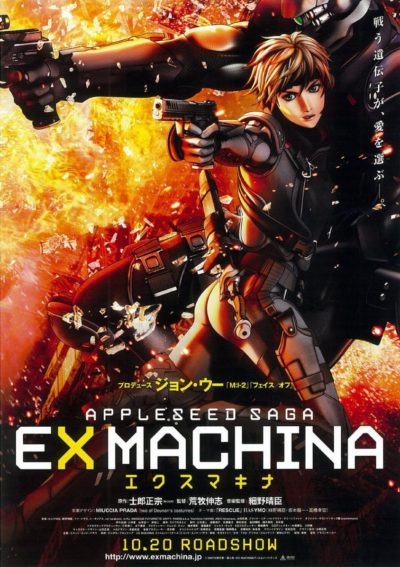 I think this is probably my favourite of the various incarnations of Appleseed. It may not be the best characterization, the best animation, or the best plot. But I think in overall terms, the combination is the most successful. In all the others, you can typically point to one of those three areas as being at least somewhat deficient. Here, if none are outstanding, they’re all solid and competent. It may help that legendary Hong Kong director John Woo was one of the producers. If you didn’t know that, you could probably tell from the early scene in which Briareos crashes through a church’s stained-glass window, a gun blazing in each hand. “All that needs is some white doves in slow-mo,” I thought. And, lo, later on, the birds in question do appear – and are even necessary to the plot, which is probably more than Woo managed!
I think this is probably my favourite of the various incarnations of Appleseed. It may not be the best characterization, the best animation, or the best plot. But I think in overall terms, the combination is the most successful. In all the others, you can typically point to one of those three areas as being at least somewhat deficient. Here, if none are outstanding, they’re all solid and competent. It may help that legendary Hong Kong director John Woo was one of the producers. If you didn’t know that, you could probably tell from the early scene in which Briareos crashes through a church’s stained-glass window, a gun blazing in each hand. “All that needs is some white doves in slow-mo,” I thought. And, lo, later on, the birds in question do appear – and are even necessary to the plot, which is probably more than Woo managed!
The story here begins with the latest in a series of terrorist attacks, carried out by cyborgs. It turns out they are not acting of their own free will, but are being “puppet mastered” into their actions. Worse, the human residents of Olympus now appear to be joining in, baffling Deunan (Kobayashio) and her colleagues in ESWAT. Viewers, however, will likely be quicker to figure out the cause there, given the rather obvious mentions of a hot new piece of wearable technology called Connexus, which simply everyone who is anyone is now sporting. Meanwhile, a new kind of soldier biodroid is being developed, basied on Briareos (Yamadera), designed to possess the talents of humans or cyborgs, but without the negative traits. After Briareos is injured, Deunan is partnered up with one, Tereus (Kishi). This freaks her out, because he looks just like Briareos, before his cybernetic upgrades. Meanwhile, Olympus leader Athena (Takashima) seeks to leverage the terrorist attacks to gain support for her plan to create a worldwide security network.
There’s a lot going here, yet the script manages to keep the elements clear and moving forward without confusion. There’s a sweet spot in SF between the simplistic and the over-complex, and this hit it better than most. The animation is a tad short, however. Weirdly, what stood out as defective was the hair, which didn’t move in the way it should. Either that, or I guess, after the apocalypse, hair lacquer is not in short supply. In general though, the technical aspects were competent enough and occasionally better than that. Perhaps due to Woo’s involvement, it feels a perfect candidate for a live-action adaptation, though the budget would need to be well into nine figures. I’d go with Ruby Rose as Deunan and Dave Bautista as Briareos. Change my mind. :) Oh, and the tagline? Yeah, some of Deunan’s outfits in the film were indeed designed by Miuccia Prada. She has been running the family’s clothing company since 1978, and was a fan of the previous film. A very well-dressed action heroine indeed…
Dir: Shinji Aramaki
Star (voice): Ai Kobayashi, Kōichi Yamadera, Gara Takashima, Yūji Kishi
Appleseed XIII: Tartaros and Ouranos
By Jim McLennan★½
“A Herculean labour to get through”
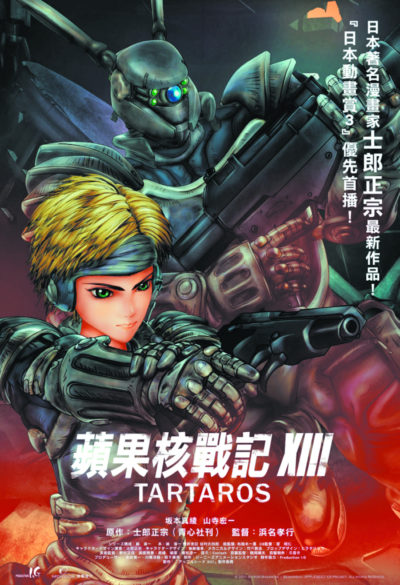 These two features, Tartaros and Ouranos, are an edited-down version of the Appleseed XIII series. This consisted of 13 episodes, each 22 minutes long, with their release beginning in June 2011 and running through the following January. Obviously, if you do the math, you can see that some fairly harsh scissoring was needed to get that down to a pair of 85-minute films. It also loses the obviously episodic nature, with some of the parts intended to be stand-alone. But, if I’m blunt, I think the problems here are considerably more intrinsic. By the end, I was glad I had decided to go with this version; the prospect of sitting through the longer version had little or no appeal at all.
These two features, Tartaros and Ouranos, are an edited-down version of the Appleseed XIII series. This consisted of 13 episodes, each 22 minutes long, with their release beginning in June 2011 and running through the following January. Obviously, if you do the math, you can see that some fairly harsh scissoring was needed to get that down to a pair of 85-minute films. It also loses the obviously episodic nature, with some of the parts intended to be stand-alone. But, if I’m blunt, I think the problems here are considerably more intrinsic. By the end, I was glad I had decided to go with this version; the prospect of sitting through the longer version had little or no appeal at all.
The most obvious problem was the animation style, which managed to combine the worst features of both CGI and traditional animation. The end result is something which looks flat-out ugly, and thus a far cry from creator Masamune Shirow’s original art. For what I can only presume was good reason, the producers decided to have 13 different animation studios handle things, each doing one episode. While they were all clearly working from the same source material, it’s obvious that they were not all equally competent. Especially when compiled together, the decent bits simply make the bad look all the worse; it would probably have been better had it all been bad. As the original 1998 OAV showed, your eyes can get use to limited animation eventually – providing it isn’t frequently been shown anything else.
The other issue is a story which felt, at best, like another warmed-over rehash of previous elements. Oh, look: pro-human terrorists are threatening the peace of Olympus. Yes, again. It also drops in weird elements which made no sense. Did you know Deunan’s mother was African, and was killed while walking across a street reserved for white people? Briareos is also African. I’m not quite sure what woke point writer Junichi Fujisaku was seeking to make with this, also a sharp deviation from Shirow’s material. But it’s so badly-handed as to actively subtract from proceedings, and has aged very poorly over the decade since. A lot of the content is “inspired by” Greek mythology, in particular the 12 Labours of Hercules, to the point it feels on occasion like a SF episode of The Legendary Journeys.
The overall story arc mostly concerns Olympus’s “Ark Project”, which is intended to secure a future for humanity, but is being opposed by the Human Liberation Front, and in particular Deia Chades. There’s also a clash between Olympus and another city-state, Poseidon, which confused the heck out of me, as in the previous version, Poseidon appeared to be a multinational conglomerate. Whatevs. To be honest, it would have been a bit of an improvement if I could have brought myself to care about this, or anything else presented here. Instead, I found myself largely uninterested in the watered-down version of Deunan which we got here – someone who seemed more concerned about getting in touch with her feelings than with kicking ass.
Dir: Takayuki Hamana
Star (voice): Maaya Sakamoto, Kōichi Yamadera, Mikako Takahashi, Hiro Shimono
Appleseed Alpha
By Jim McLennan★★★½
“Before the war”
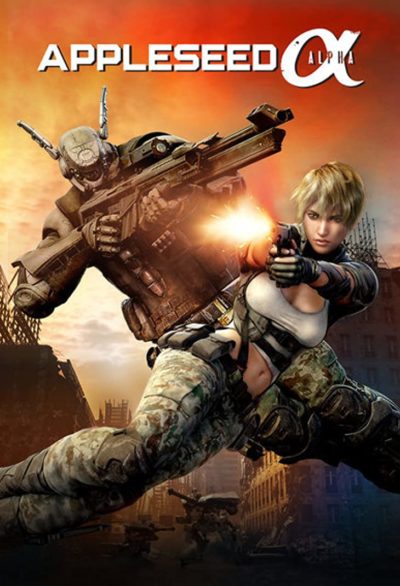 Though the most recent story told in the Appleseed universe, at the time of writing, this was the first to take place. It’s set before Deunan (Christian) and Briareos (Matranga) arrived in Olympus, back when they were still struggling to survive in the harsh world of the 22nd century, created by World War III. They are a pair of former soldiers, operating in New York, doing jobs of questionable legality for boss of the Big Apple’s underworld, Two Horns (Calvert). Their latest mission is to clear an area of automated drones, which now attack anyone who enter. While doing so, they rescue Iris (Palencia) and Olson, who are being pursued by Talos. He’s a cyborg, who needs Iris in particular to access and control a land battleship, which he’ll use to destroy New York, because… Uh, I’m sure he has his reasons. They’re just not very clearly explained in this installment.
Though the most recent story told in the Appleseed universe, at the time of writing, this was the first to take place. It’s set before Deunan (Christian) and Briareos (Matranga) arrived in Olympus, back when they were still struggling to survive in the harsh world of the 22nd century, created by World War III. They are a pair of former soldiers, operating in New York, doing jobs of questionable legality for boss of the Big Apple’s underworld, Two Horns (Calvert). Their latest mission is to clear an area of automated drones, which now attack anyone who enter. While doing so, they rescue Iris (Palencia) and Olson, who are being pursued by Talos. He’s a cyborg, who needs Iris in particular to access and control a land battleship, which he’ll use to destroy New York, because… Uh, I’m sure he has his reasons. They’re just not very clearly explained in this installment.
That’s one of the few mis-steps in this, even if it does kinda rewrite established franchise history about how Deunan and Briareos got to Olympus. It’s a wonderful glimpse into a blasted world, with New York eerily short on people, and far from the bustling metropolis it was, pre-war. Oddly, the subway still seems to function, as we see in the opening scene, when D+B are attempting to complete one of Two Horns’s jobs, delivering a vaccine to him. Let’s just say, this particular subway line may be experiencing delays for a bit. I actually watched this back-to-back with the original 1998 film, and there’s a drastic contrast in style, with the CGI here slick and generally showing impressive detail. There are some jarring exceptions; a car flipping over looks like no effort went into it at all. But the finale involving the land battleship is undeniably spectacular, and may be good enough to make you forget the earlier glitches. Always good to finish on a high, and this certainly does.
Its plot is not dissimilar to the original 1988 version, with a young girl the key to a terrorist acquiring a weapon of mass destruction. The main difference is that D+B are operating as independent contractors, rather than state-sponsored security. This probably makes their actions more heroic; they could simply have walked away from Iris and Olson, as not their problem. But perhaps the most interesting character arc belongs to Two Horns, who goes from employer to enemy, before eventually riding to the rescue after discovering, first-hand, how much of a bastard Talos and his sidekick, Nyx, can be. I must admit though, to finding Deunan’s costume a tad distracting, since it appears to be designed largely to draw attention to her beautifully detailed, CGI cleavage. While I’m not typically going to complain about that kind of thing, the rest of the film is rather too classy for this to be needed.
Dir: Shinji Aramaki
Star (voice): Luci Christian, David Matranga, Wendel Calvert, Brina Palencia
[While it seems odd, I believe the English language version is actually the original, with the Japanese being the “dub” in this case]

















